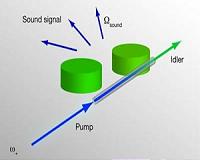 |
Boulder CO (SPX) Feb 23, 2010 For nearly half a century, scientists have been trying to figure out how to build a cost-effective and reasonably sized X-ray laser that could, among other things, provide super high-resolution imaging. And for the past two decades, University of Colorado at Boulder physics professors Margaret Murnane and Henry Kapteyn have been inching closer to that goal. Recent breakthroughs by their team at JILA, a joint institute of CU-Boulder and the National Institute of Standards and Technology, have paved the way on how to build a tabletop X-ray laser that could be used for super high-resolution imaging, while also giving scientists a new way to peer into a single cell and gain a better understanding of the nanoworld. Both of these feats could lead to major breakthroughs in many fields including medicine, biology and nanotechnology development. "Our goal is to create a laser beam that contains a broad range of X-ray wavelengths all at once that can be focused both in time and space," Murnane said. "If we have this source of coherent light that spans a huge region of the electromagnetic spectrum, we would be able to make the highest resolution light-based tabletop microscope in existence that could capture images in 3-D and tell us exactly what we are looking at. We're very close." Murnane and Kapteyn presented highlights of their research today at the American Association for the Advancement of Science, or AAAS, annual meeting in San Diego, during a panel discussion about the history and future of laser technology titled "Next Generation of Extreme Optical Tools and Applications." Most of today's X-ray lasers require so much power that they rely on fusion laser facilities the size of football stadiums or larger, making their use impractical. Murnane and Kapteyn generate coherent laser-like X-ray beams by using an intense femtosecond laser and combining hundreds or thousands of visible photons together. And the key is they are doing it with a desktop-size system. They can already generate laser-like X-ray beams in the soft X-ray region and believe they have discovered how to extend the process all the way into the hard X-ray region of the electromagnetic spectrum. "If we can do this, it could lead to all kinds of possibilities," Kapteyn said. "It might make it possible to improve X-ray imaging resolution at your doctor's office by a thousand times. The X-rays we get in the hospital now are limited. For example, they can't detect really small cancers because the X-ray source in your doctor's office is more like a light bulb, not a laser. If you had a bright, focused laser-like X-ray beam, you could image with far higher resolution." Their method can be thought of as a coherent version of the X-ray tube, according to Murnane. In an X-ray tube, an electron is boiled off a filament, then it is accelerated in an electric field before hitting a solid target, where the kinetic energy of the electron is converted into incoherent X-rays. These incoherent X-rays are like the incoherent light from a light bulb or flashlight - they aren't very focused. In the tabletop setup, instead of boiling an electron from a filament, they pluck part of the quantum wave function of an electron from an atom using a very intense laser pulse. The electron is then accelerated and slammed back into the ion, releasing its energy as an X-ray photon. Since the laser field controls the motion of the electron, the X-rays emitted can retain the coherence properties of a laser, Murnane said. Being able to build a tabletop X-ray laser is just the beginning, said Kapteyn. "An analogy that is pretty close to what is going on in this field is the MRI, which started as just a fundamental investigation," said Kapteyn. "People then started using it for microscopy, and then it progressed into a medical diagnostic technique."
Share This Article With Planet Earth
Related Links University of Colorado at Boulder Space Technology News - Applications and Research
 Quantum Leap For Phonon Lasers
Quantum Leap For Phonon LasersWashington (SPX) Feb 23, 2010 Physicists have taken major step forward in the development of practical phonon lasers, which emit sound in much the same way that optical lasers emit light. The development should lead to new, high-resolution imaging devices and medical applications. Just as optical lasers have been incorporated into countless, ubiquitous devices, a phonon laser is likely to be critical to a host of as yet unim ... read more |
|
| The content herein, unless otherwise known to be public domain, are Copyright 1995-2010 - SpaceDaily. AFP and UPI Wire Stories are copyright Agence France-Presse and United Press International. ESA Portal Reports are copyright European Space Agency. All NASA sourced material is public domain. Additional copyrights may apply in whole or part to other bona fide parties. Advertising does not imply endorsement,agreement or approval of any opinions, statements or information provided by SpaceDaily on any Web page published or hosted by SpaceDaily. Privacy Statement |